Did you know that 16% of all eCommerce sales in the U.S. and Canada come from affiliate marketing alone? That number outweighs email marketing! (Business Insider)
So, tapping into affiliate marketing and starting your own program is a great way to boost sales and get more people to know your brand—if you do it right.
But being successful with affiliate marketing isn’t easy. It seems like a lot of work to do: create an offer, attract affiliate marketers, select an affiliate manager software, and so much more.
It’s no wonder you feel overwhelmed right now.
How do you go about launching and running your affiliate program confidently without missing anything important? An affiliate marketing checklist is of assistance in this case.
In this article, we’ll provide you with a comprehensive affiliate program checklist with 16 criteria to ensure that everything has been done correctly:
- Set clear goals and KPIs
- Choose products to include in your program
- Do market research on competitors’ commission rates
- Determine your affiliate commission structure
- Select payment methods and schedule
- Write affiliate terms and conditions
- Choose the right affiliate marketing software
- Create an affiliate signup page
- Recruit high-quality affiliates
- Onboard and train affiliates
- Offer affiliates marketing assets and dashboards
- Track and optimize affiliate performance
- Communicate and foster relationships with affiliates
- Motivate affiliates with extra bonuses
- Prevent affiliate fraud
- Comply with laws and regulations
Now, let’s jump right in!
With an easy affiliate program setup, attractive rewards, and robust tracking features, UpPromote is the perfect tool to grow your business through affiliate marketing.
The 16-Point Affiliate Program Checklist for Your Business
1. Define your goals and KPIs
First, you must know what to expect before right-hand diving into the campaign. Having a clear and well-defined goal in mind does actually give a guideline to success.
Are you hoping to:
- Drive more overall sales?
- Increase sales of a particular product line?
- Attract more visitors to your store website?
- Improve the customer retention rate?
Consider using the SMART model, which states specific goals. SMART stands for Specific, Measurable, Achievable, Relevant, and Time-bound.
To make it easier to understand, see the following examples:
- Reach X in total sales over 3 months by collaborating with Y affiliates.
- Boost Product B sales by X% next quarter by offering a special discount code for Y influencers.
- Have X new visitors next month due to working with Y bloggers.
- Increase customer retention by X% in 2 months. Offer your existing customers a special deal if they successfully refer friends to your store.
Also, consider the KPIs that will help you evaluate how well you’re meeting your goals. Some common KPIs you should pay attention to include:
- Clicks and traffic
- Sales and revenue
- Conversion rate
- Average order value (AOV)
- Return on investment (ROI)
- Customer lifetime value (CLV)
By clearly setting goals and monitoring relevant KPIs, you can make sure your affiliate campaign is effective and helps reach your overall business goals.
2. Pick your products for affiliates to promote
If you are new to affiliate marketing, choosing one or two products to start with can be a good choice. Let’s consider items that are profitable and popular among your customers.
When deciding what type of product to include in your affiliate program, you should choose:
- Best-sellers: Look at your sales records to identify your top-selling products. Sought-after products are easier for affiliates to share and promote.
- High-priced items: These bring greater commission rewards, which can motivate affiliates to push them more. Earning 10% on a $150 product is more rewarding than on a $10 one, right?
- Trending products: Use tools like Google Trends or keyword research to identify products that are currently in demand. Seasonal or holiday-related items let affiliates tap into current trends and draw customer attention.
- A new product line: If you’re launching something new, pick it for your affiliate campaign. Your partners can generate buzz around the product, making it stand out in the market.
If you own a beauty and cosmetics brand, take inspiration from Glossier.
As soon as Glossier launched its new fall and winter lipstick line, it teamed up with influencers to spread the word. With this tactic, Glossier captivated thousands of beauty lovers to make purchases in just a short time.

Want to follow Glossier’s strategy and set up a separate affiliate program for a specific product or collection in your store? That’s perfectly fine if you use UpPromote.
Enable UpPromote’s special product commission feature & attract top talents to boost your exclusive product sales.
Within our app, navigate to Programs > Locate a program > Click the program name > Special product commission.
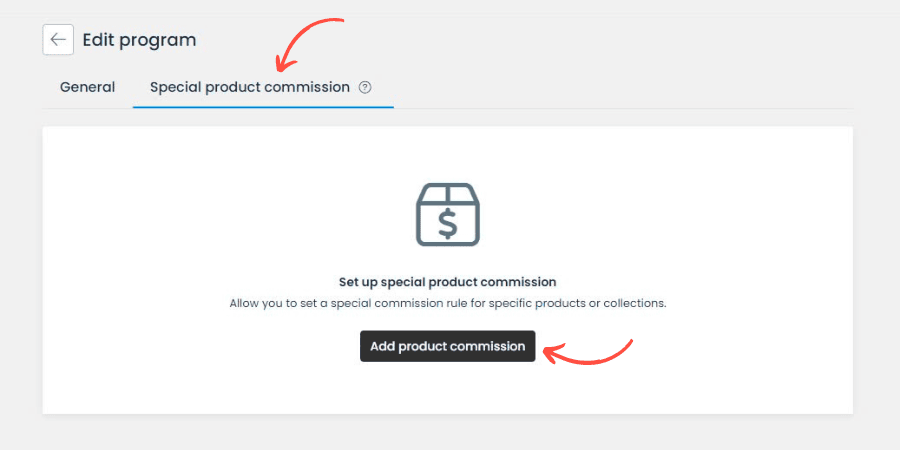
From here, you can add a specific product or an entire collection and set the commission rate you want to provide.
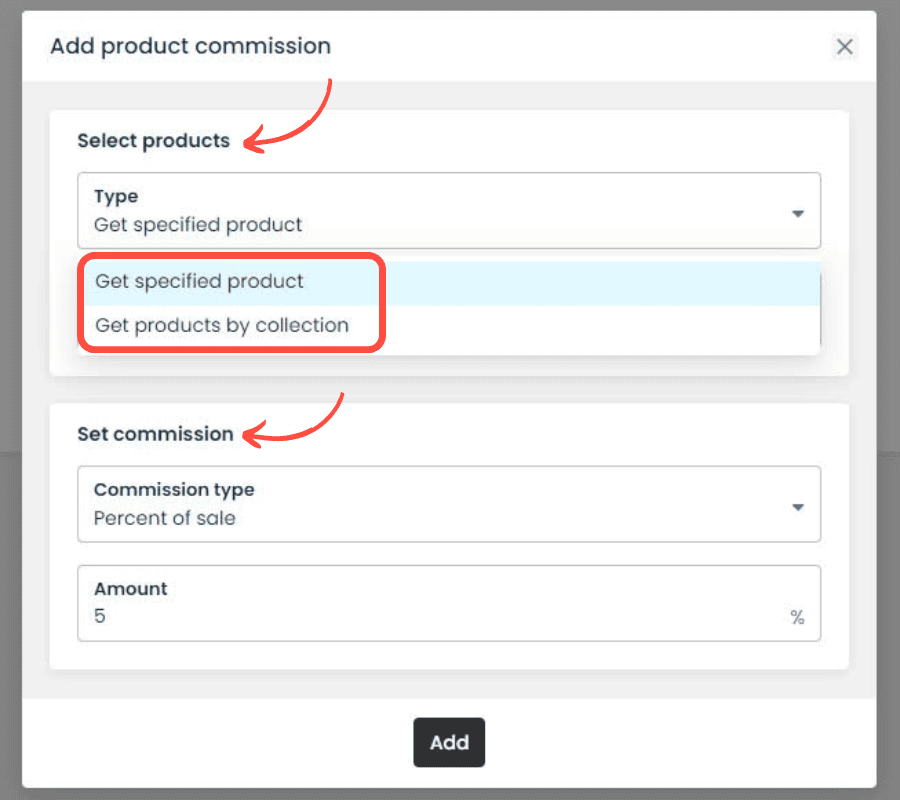
3. Conduct market research on competitors’ commissions
Do you know that over 80% of brands around the world use affiliate marketing to boost their sales (Rakuten)? And yes, this includes other companies in your niche.
So, looking at your competitors is a smart move. It gives you an overview of what they are offering to affiliates and helps you set a perfect commission rate for your own campaign. If your commission is too low, affiliates may go elsewhere. On the other hand, if it’s too high, it could hurt your profit margins.
Following are ways to do research on competitor affiliate program commission rates:
- Visit your competitor’s sites to see their affiliate program’s details, including commission, pay schedules, and performance incentives.
- Engage with online communities related to affiliate marketing on Facebook, LinkedIn, or Quora. Participate in discussions or search through threads to gather information about typical commission rates in your field.
- Look for reports that list the average commission rates for your industry. Rakuten Advertising, Business Insider, eMarketer, and AffStat are some reliable resources for you to explore.
- Sign up for popular affiliate networks like ShareASale, Impact, or UpPromote’s Marketplace. Explore the offer lists within your niche to compare the commission rates of other brands.
For example, before launching a home & tool affiliate program, you can join UpPromote’s Marketplace and view what your competitors are providing affiliate marketers.
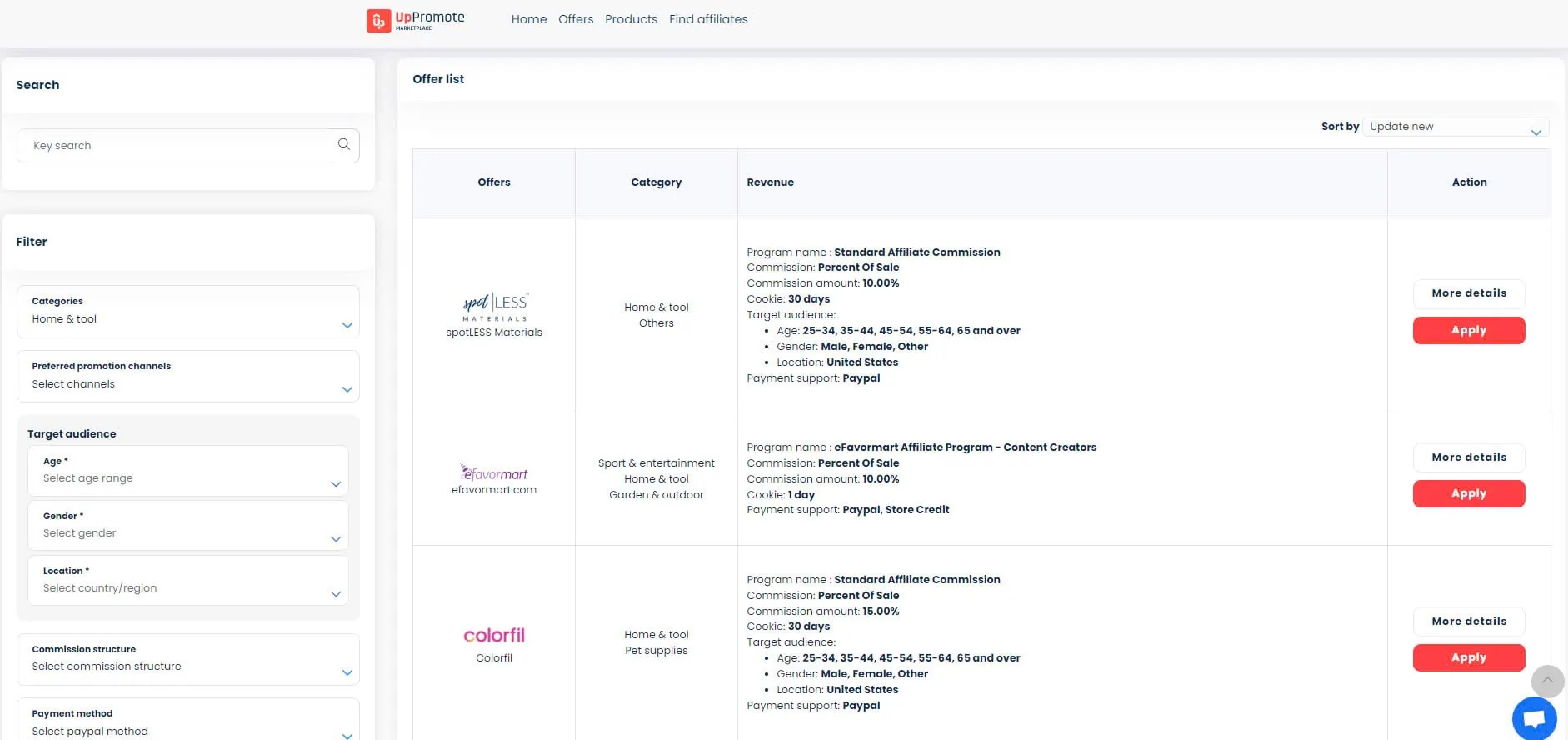
4. Determine the affiliate program commission structure
Having researched your competitors’ commission rates, it’s finally time to structure your own. One key thing to remember: your commission structure is competitive and attractive against theirs.
First, think about a commission model that you will apply to your program. Consider choosing among those popular ones:
- Percent of sale: Affiliates earn a percentage of their total sales, e.g., 15% of the total order amount.
- Flat rate per item: Affiliates are paid based on each product sold, e.g., $5 per item.
- Flat rate per order: Affiliates receive a fixed amount per referred order, e.g., $10 per order.
- Tiered commission: Affiliates get more as they reach higher sales targets, e.g., 10% for sales under $400 and 20% for sales over $400.
Once again, think about your goals to find out which type of commission works well for your program.
To boost sales, offer a high percentage on each sale. This will encourage affiliates to promote your store’s products.
On the other hand, in case you want to increase specific product line revenue, a flat rate per item or a tiered commission could be effective.
Further, to differentiate your offers from competitors’, consider setting a tiered commission structure, like the way Tréskin has done.
Through UpPromote, the top-recommended affiliate marketing app on Shopify, the brand sets a special commission structure with 4 different levels like this:
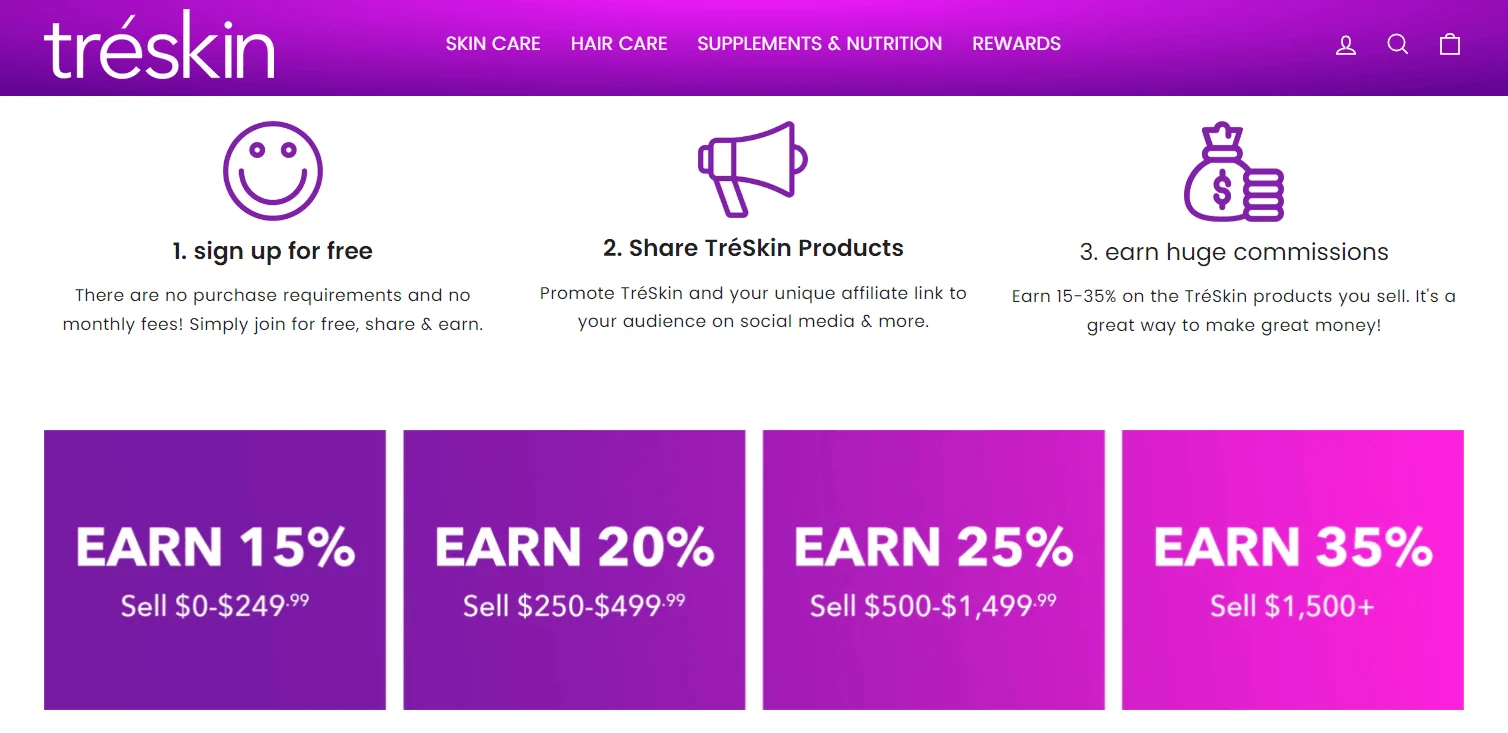 In short, Tréskin’s affiliates who bring more sales can earn more commissions, between 15% and 35%.
In short, Tréskin’s affiliates who bring more sales can earn more commissions, between 15% and 35%.
With such an appealing commission structure, Tréskin has attracted many high-quality beauty bloggers and influencers and encourages them to sign up for its affiliate campaign.
Join 115,000+ UpPromote users to create dynamic commission structures that outsmart your competitors.
5. Set payment methods and schedule
Along with setting a commission structure, choosing a payment method and schedule should be on your checklist. This ensures that you send commissions to their partners smoothly and on time.
Choose a payment method for affiliates
There are 6 popular affiliate payout solutions for your consideration:
- PayPal
- Bank transfer
- Store credit
- Check
- Debit/ Credit card
- Gift cards
Keep these factors in mind to find the best affiliate marketing payment method for your brand:
- Cost: Every payment method comes with its own fees. If transaction costs are high, they can eat into your profit. Be sure to assess the cost carefully.
- Speed: Speed is crucial. Quick and timely payments give your affiliates confidence and motivation.
- Security: A secure payment system fosters trust and safeguards both parties’ finances.
- Convenience: Make the payment process easy for both you and your affiliates. Using automated payments can reduce manual work and minimize errors.
- International compatibility: If your affiliates are from different countries, the payment method’s international compatibility is essential.
- Affiliate preferences: Some affiliates prefer bank transfers, while others favor digital wallets for quicker access. Offering flexible payment options lets affiliates choose what works best for them.
Schedule affiliate payment
Determine a regular timeline for paying your affiliates: weekly, bi-weekly, monthly, or whatever flow works for your business and for them.
Setting up a regular payout schedule helps to establish better trust and dependability with the affiliates. It gives them a sense of financial security and satisfaction regarding your program.
Set affiliate payment thresholds
Establishing an affiliate payout threshold means payments are processed only when affiliates reach a specific commission amount. This not only helps you minimize the frequency of small transactions but also encourages your partners to generate more sales to meet the minimum earnings required for a payout.
Take Amazon as an example. Amazon sets a $10 minimum for affiliates who want a direct deposit or gift certificate, while the threshold for checks is $100. Affiliates who do not reach the threshold will have their payments rolled over to the following month until they do.
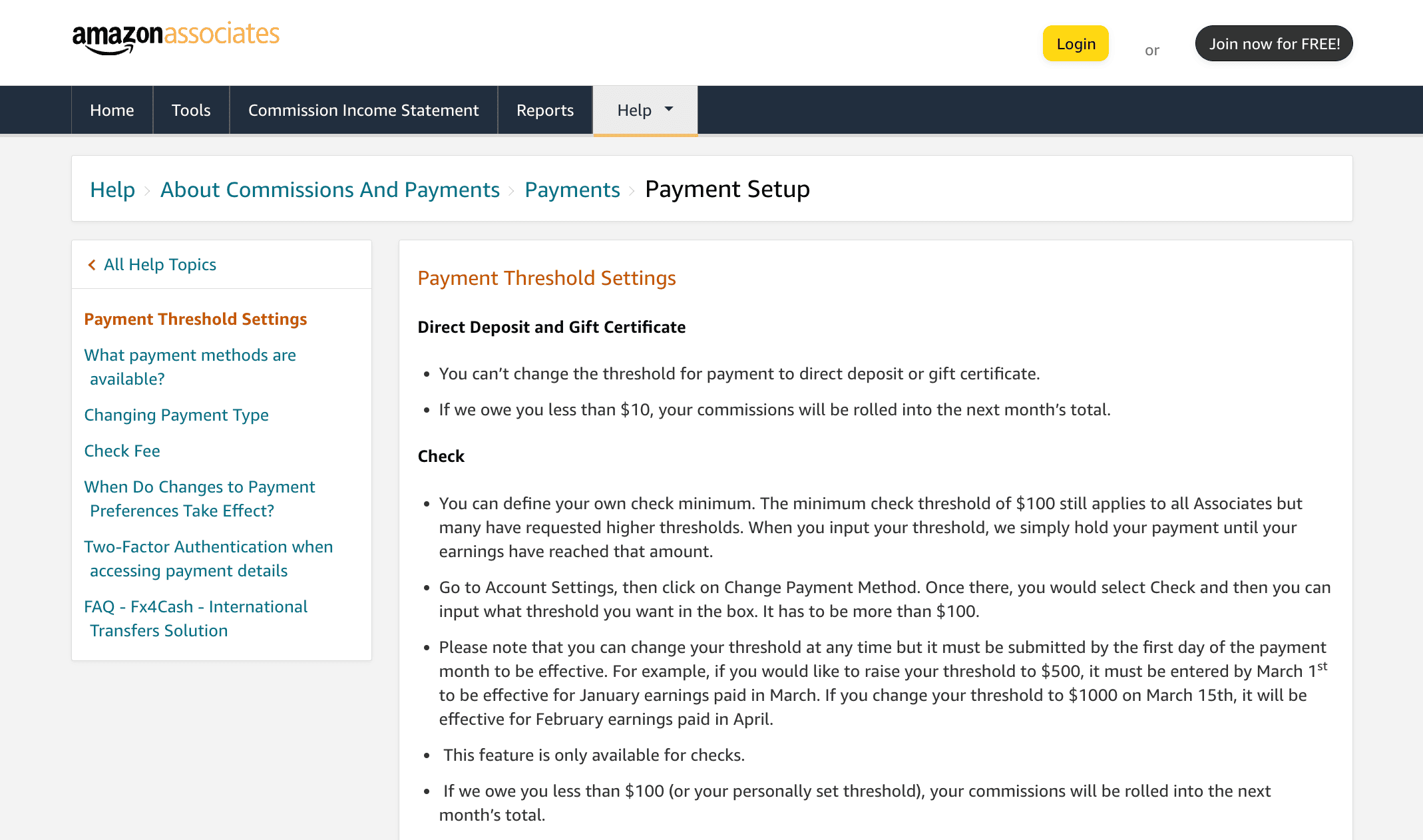
With UpPromote, you can easily set up payment methods for your programs.
Navigate to Settings > Payment > Payment Settings. Then, select a payment option: Venmo, bank transfer, or credit. Your affiliates will see the chosen options on their accounts.
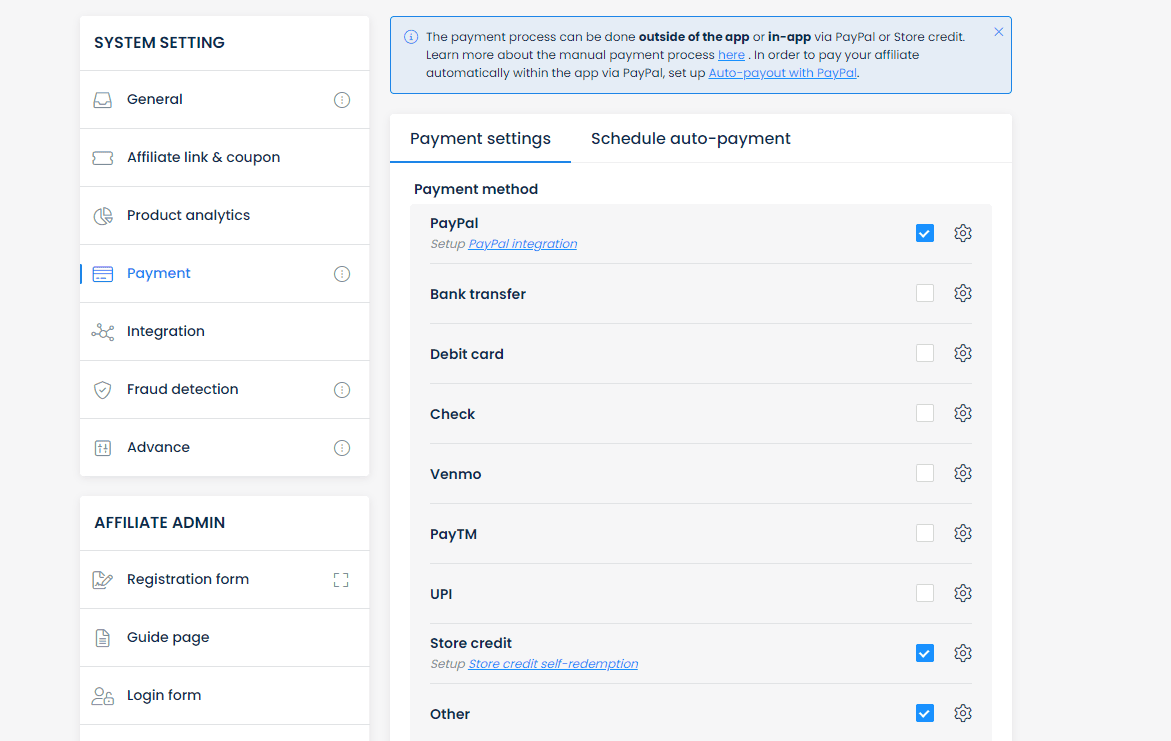
And the best part? Schedule automatic payouts via PayPal and say goodbye to manual tasks.
To enable this, go to Settings > Payment > Schedule payment. Then, you can enable the Auto-payout with PayPal toggle.
From there, you can create an even more personalized payment schedule and set flexible thresholds to match your financial goals.
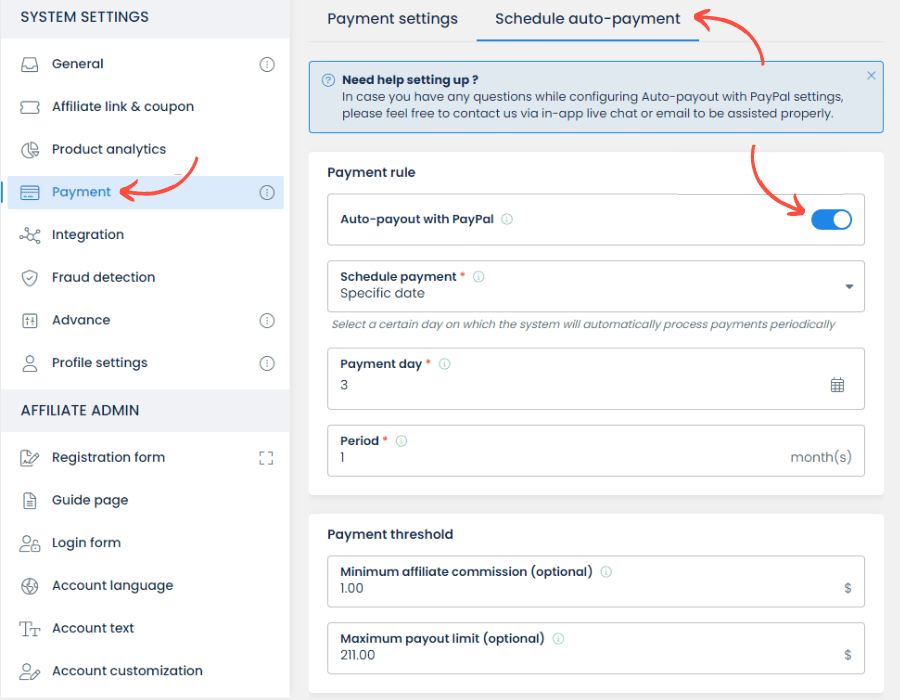
6. Craft affiliate program policies
Don’t ignore the importance of writing terms and conditions for your affiliate program.
Clear and detailed terms and conditions help protect your business and set clear expectations for your affiliate marketers, reducing misunderstandings or disputes.
When crafting an affiliate agreement for your program, be sure to cover the following:
- Program rules: Define who is perfect to join, how candidates can enroll, and outline their responsibilities.
- Marketing guidelines: Specify how affiliates should represent your brand, detail the marketing materials you’ll provide, and clarify which activities are prohibited, such as spamming or misleading advertisements.
- Commission structure: Describe how affiliate commissions are calculated and paid.
- Referral tracking: Explain how affiliate referrals will be tracked, including your cookie policy and any other tracking methods.
- Legal components: Address confidentiality, proprietary rights, and termination terms.
Take a look at Tréskin, for instance, one of the favorite organic brands in the U.S. Tréskin drafted clear and concise terms to set the foundation for its affiliate program and minimize confusion for the partnerships at the very outset.
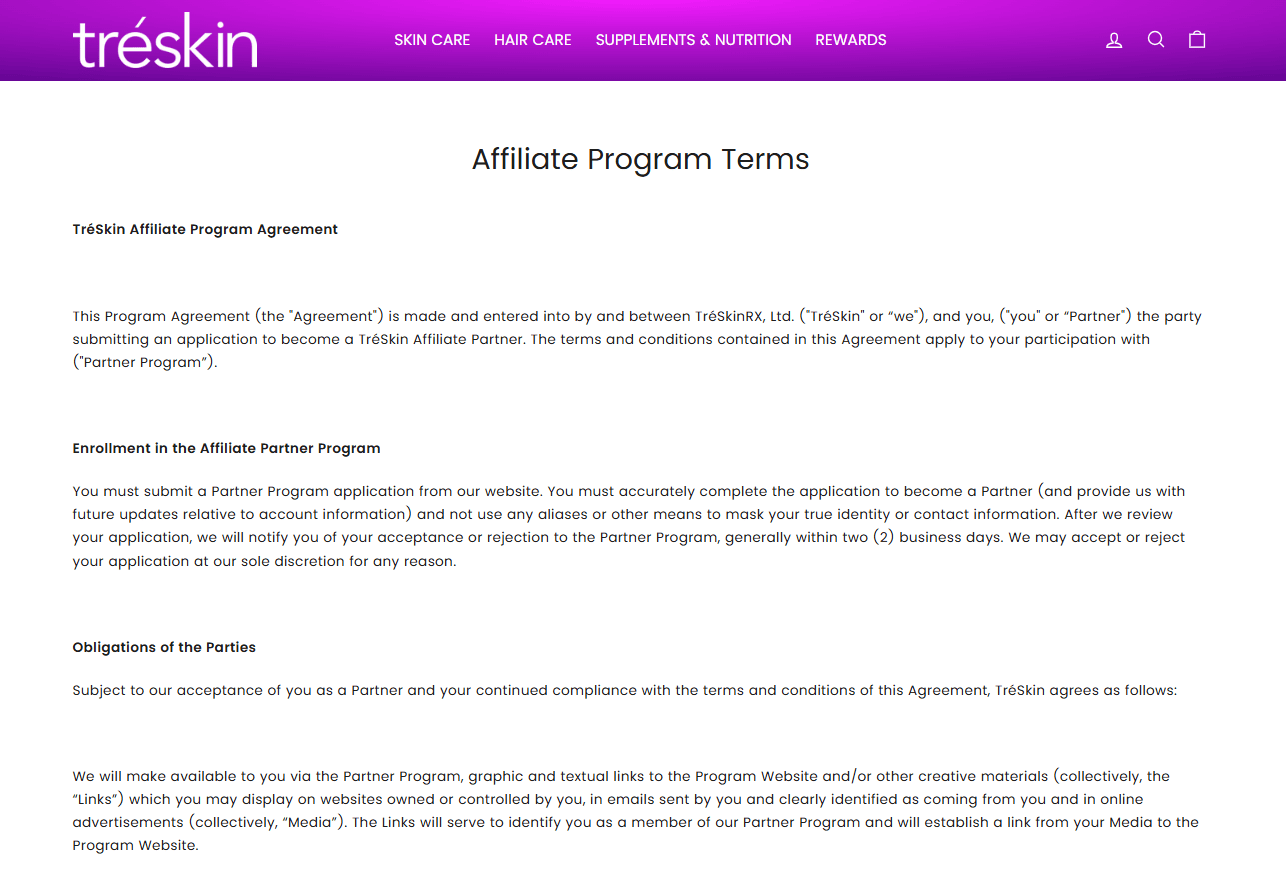
Bonus tip: Have a lawyer review your affiliate terms and conditions to make sure that they meet all of the pertinent legal requirements for your business.
7. Choose the right affiliate marketing tools
Selecting the right affiliate management software is essential for all brands tapping into affiliate marketing, whether small businesses or large corporations. Use it to create, run, and manage affiliate programs effortlessly, eliminating manual tasks.
What features should you look at to get the right software for your brand?
- Ease of use and user-friendly interface
- Automated tracking and commission calculation
- Pricing and scalability
- Customer support and training
- Language and currency options
To find a solution that addresses all these needs, UpPromote is worth checking out.
The app is designed to support brands of any size with affiliate marketing and is now trusted by more than 115,000 users worldwide.
Here’s what UpPromote brings to the table:
- Affordable and flexible pricing options, starting with a free plan, letting you try UpPromote with no upfront costs.
- A simple interface with built-in tooltips for seamless navigation.
- Quick and easy setup, so you can get your affiliate program live in minutes.
- 24/7 customer support to ensure a smooth setup and hassle-free management.
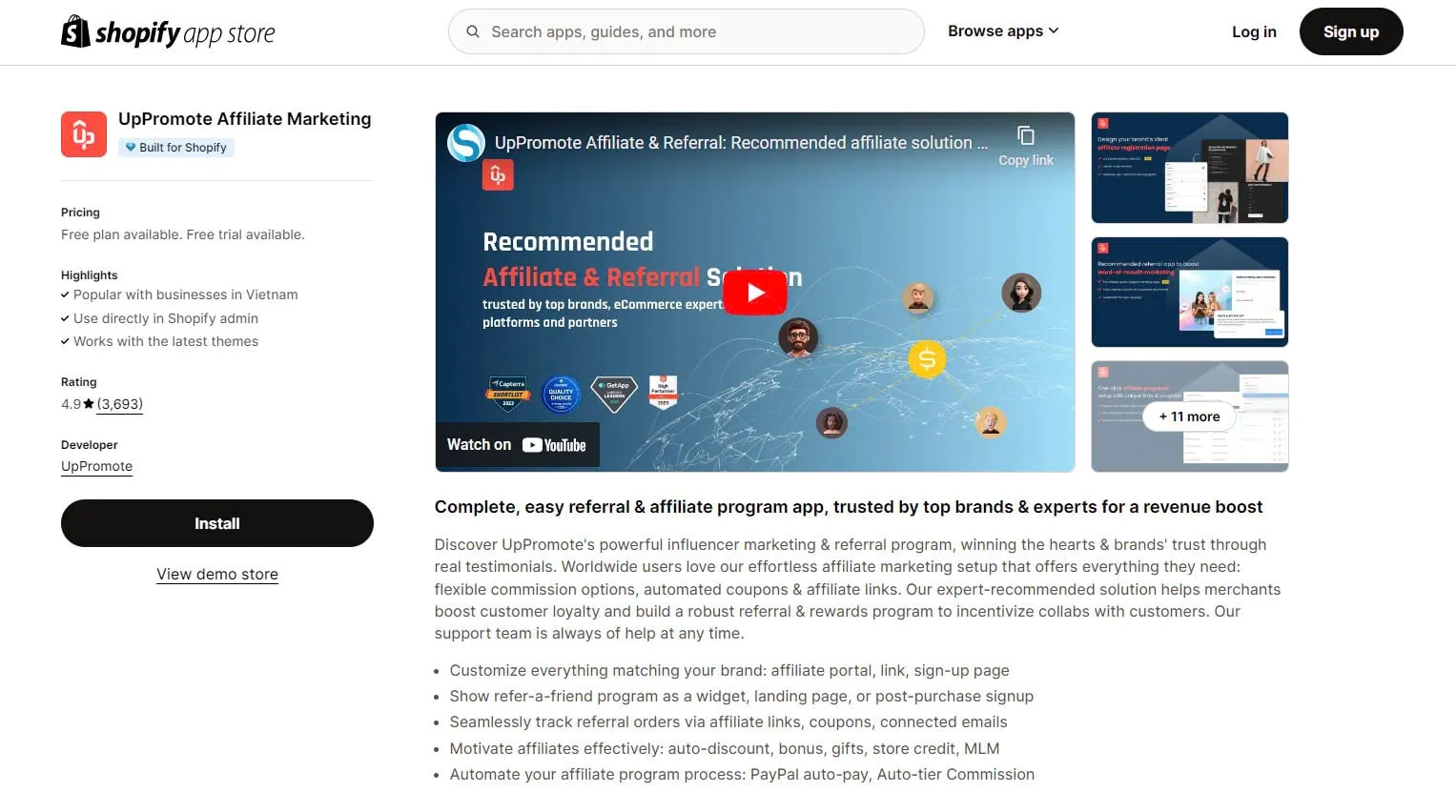
8. Create an affiliate signup page
An affiliate sign-up page invites anyone interested in your brand to join your affiliate program. So, remember to add the creation of an affiliate sign-up page to your program checklist.
Having an affiliate registration-focused landing page will empower you to clearly state the main benefits of your campaign in front of affiliates: a competitive commission structure, extended cookie period, additional bonuses, and more.
You can also provide clear instructions and forms for a potential partner to fill in, making the process of signing up quick and easy.
Take a look for inspiration at how meal delivery service HelloFresh sets up a landing page to highlight program perks and drive affiliate sign-ups.
Once affiliates reach HelloFresh’s sign-up page, they immediately see key benefits such as high commissions, long cookie duration, generous incentives, and many more. Then, they only need to click the call-to-action buttons on the page and further fill out a registration form to become a partner with HelloFresh.

Looking to design an eye-catching landing page that highlights your offer and motivates potential partners to complete the affiliate form?
You can discover and utilize affiliate signup form templates on UpPromote, to customize your own.
Access UpPromote’s ready-to-use templates & create a well-designed affiliate signup page—fast, easy, no coding needed.
Our system provides you with 3 templates:
- The Basic Template: Offer standard options for building a registration form.
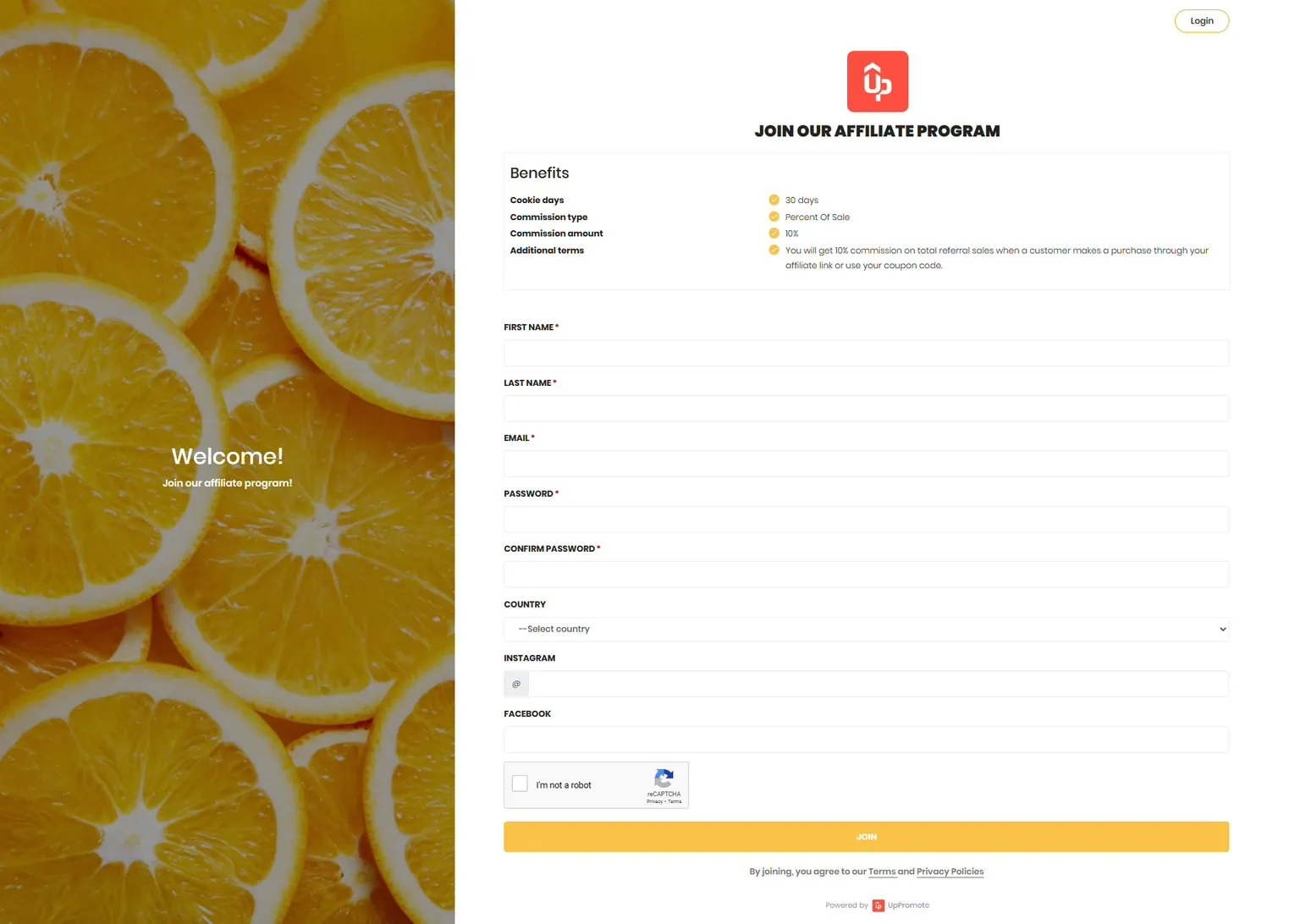
- The Trendy Template: Give a modern and captivating look with dynamic sections.

- The Comfort Template: Add a touch of elegance with diverse layouts

9. Recruit high-quality affiliate marketers
Your affiliate campaign only becomes truly active when affiliates get on board. That’s why the plan to recruit affiliate marketers must be in your affiliate marketing checklist.
But how and where can you begin?
Here are some popular ways to find affiliate partners that you can apply:
Include your affiliate program page in the website’s footer/header
Once you’ve designed an attractive affiliate registration page, a great strategy is to promote it on your website. Placing the link in the header or footer makes it easily accessible and visible to your potential affiliates, much like how Framebridge has done.
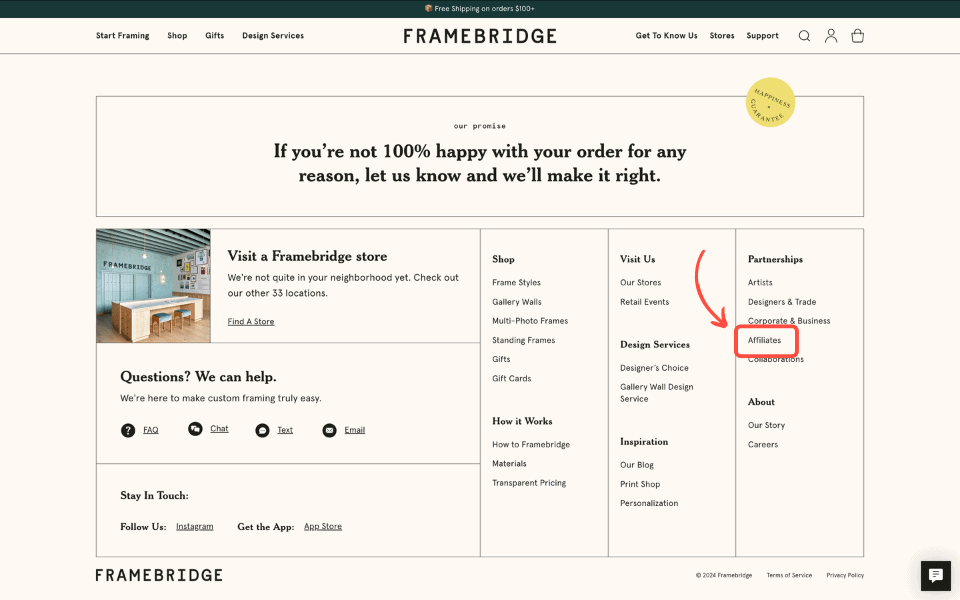
Bonus tip: Promote your affiliate registration page to increase the chances of affiliates finding and joining your program. Share it on social networks, run ads, and optimize it for search engines.
Use social media
Another strategy to get the attention of future affiliates is to announce your affiliate program on your social channels: Instagram, Facebook, or LinkedIn.

You can also use specific keywords or hashtags in your industry to identify bloggers, content creators, or influencers who may advocate on behalf of your brand.
Join extensive affiliate networks
Participating in a popular affiliate marketing network like ShareASale, Impact, Rakuten, or UpPromote’s Marketplace is a great way to connect with a wide range of potential affiliates.
For example, if you are the owner of a beauty store on Shopify, you can discover UpPromote’s Marketplace to find potential partners.
There are two ways to search for partners that match your business:
- First, showcase your offers on UpPromote’s Marketplace to attract interest:
You can set specific criteria for affiliates (age, gender, location, and preferred promotion channels).
After that, provide details about your campaign, including commissions, payment methods, and product descriptions, as well as information about your brand (such as the store domain, banners, hashtags, etc.) to make your program more compelling and competitive.
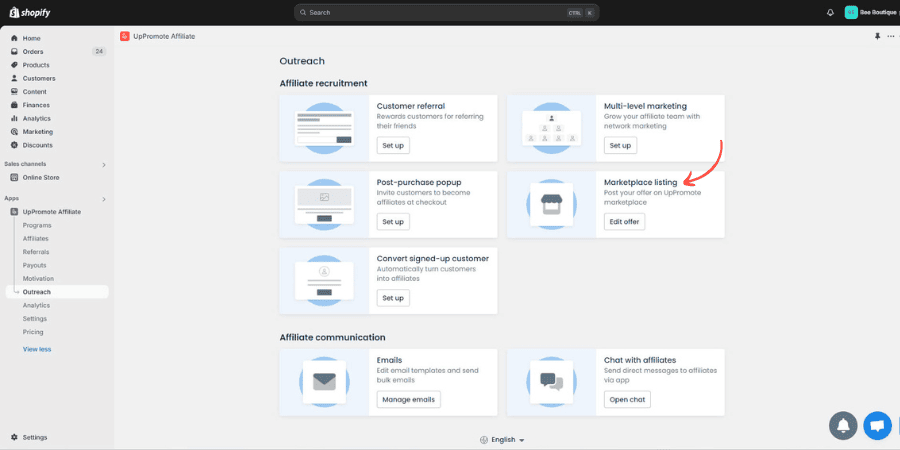
- Second, connect affiliates directly in the UpPromote Marketplace.
Dive into the beauty niche to find quality affiliates.
Check their bio, relevant industry experience, language used, location, and social media presence. Then, pick the perfect influencers for your brand and immediately invite them to your program.
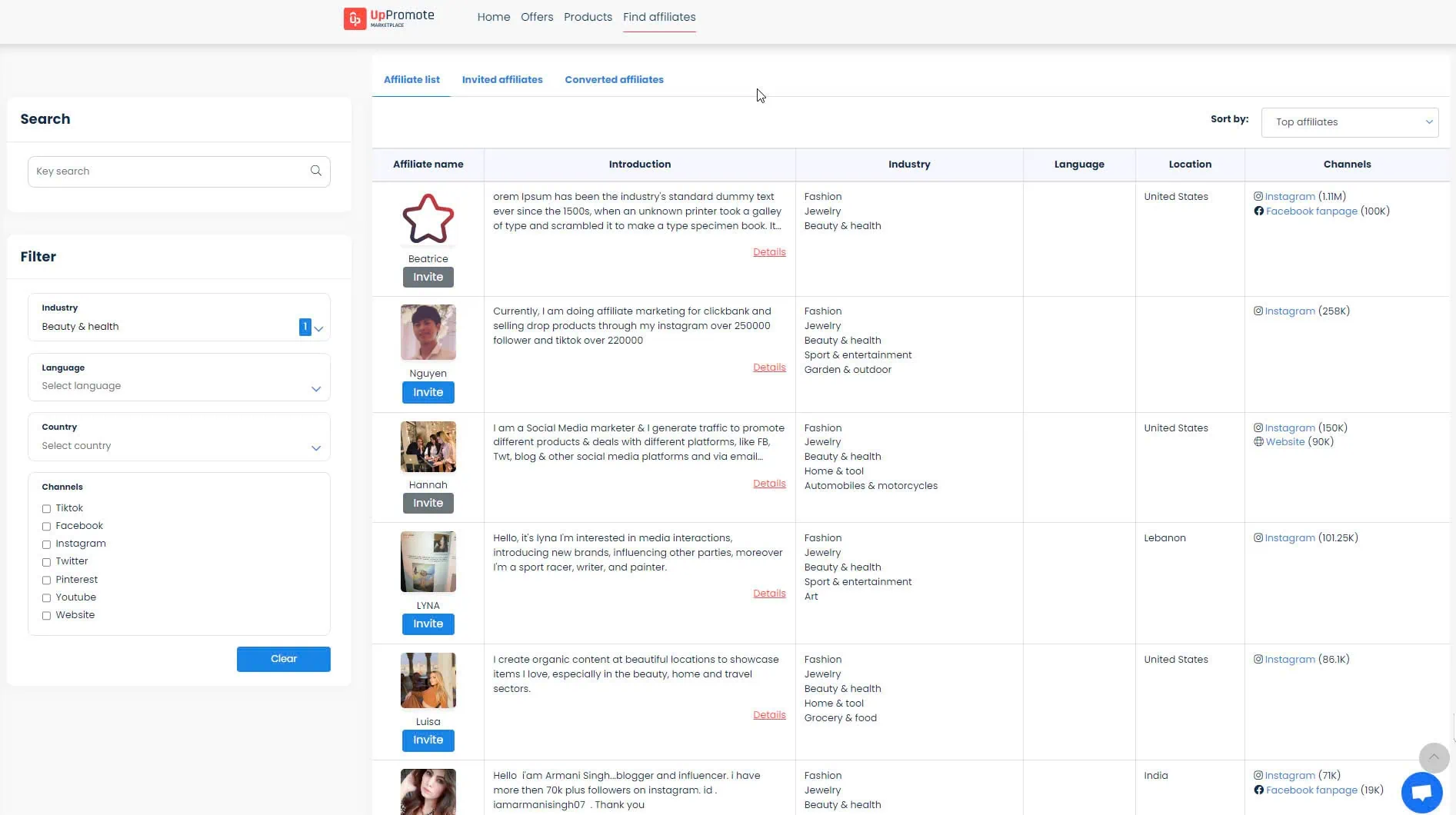
UpPromote Marketplace is now home to more than 20,000 affiliates, giving you access to a vast pool of potential partners.
Recruit top-notch affiliates on UpPromote Marketplace today!
Leveraging your existing customer base
Did you know that 92% of people trust recommendations from friends and family over advertising? So, don’t underestimate the huge potential of converting your happy customers into brand promoters.
But how can you do that? The answer lies in creating a refer-a-friend program.
That’s exactly what many brands have done, including Estée Lauder.
Estée Lauder asks customers to share their love for its products with friends to receive a special discount on their next purchase.

Looking to duplicate Estée Lauder’s strategy to turn delighted customers into affiliates?
Try UpPromote, the all-in-one referral and affiliate marketing solution on Shopify, to build your refer-a-friend program for free right away.
UpPromote provides you with 2 options to introduce your offer to customers:
- Landing page
- Widget
Landing page
With this option, you can easily embed a signup form on any page of your store. Your customers can register in no time and quickly get the referral links to promote your products.

Widget
If used, UpPromote’s widget display will be a floating button on your website. Once clicked, this button will open into a popup form allowing customers to sign up for your referral program and receive their referral links.
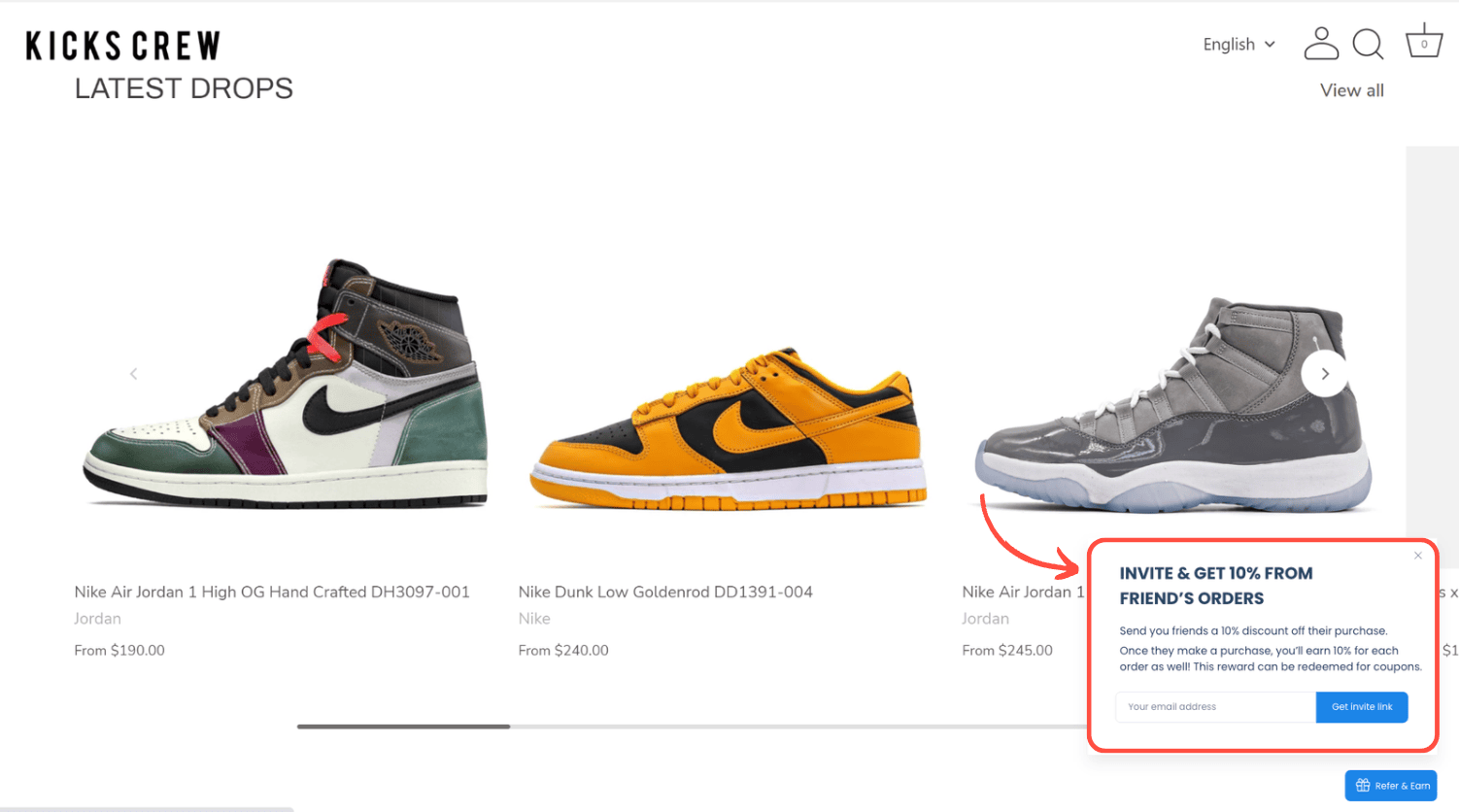
Of course, there will be more ways to find affiliates to promote your products and services, such as attending industry events, engaging in affiliate forums, or conducting a Google search.
However, no matter what your recruitment method is, keep in mind that:
- Check the affiliates’ profiles carefully to see whether they have a strong online presence with high engagement rates and if their audience fits yours.
- Review their content to ensure that it aligns with your brand’s values and personality.
10. Onboard and train your affiliate partners
A structured onboarding process lays the foundation for success in running an affiliate program.
Start by sending them a welcome onboard message.
Follow that with an onboarding kit, including key information regarding products, branding guidelines, commission structures, and marketing material.
For quick starters, give them step-by-step guides. Show them how they will navigate the affiliate dashboard, monitor their earnings, and access their promotional tool.
With UpPromote, you can easily welcome new affiliates via email. Go to Outreach > Manage Emails. Using our template or editing a message to welcome your new partners.
Next, turn on the Status button. Our system will automatically handle the delivery to your affiliates.
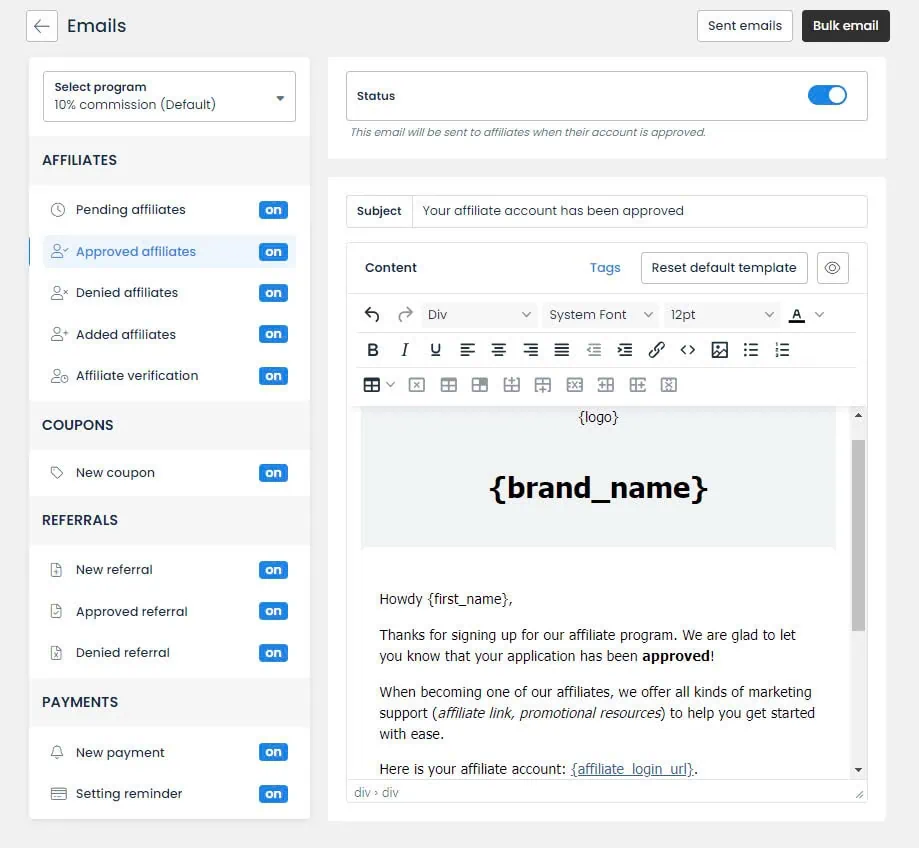
Our app also helps you provide affiliates with a comprehensive guide right from the start.
Navigate to Settings > Affiliate admin > Guide page, where you can upload a walkthrough video, notes, or important announcements for your partners.
Affiliates can access this information through the Guide tab in their dashboard after logging in.
 11. Provide affiliates with marketing materials and dashboards
11. Provide affiliates with marketing materials and dashboards
Preparing high-quality marketing materials and a good working space for your affiliates should be part of your affiliate program checklist. Here’s the reason why:
- Giving affiliates access to ready-made marketing assets, like banners, product images, and email templates, helps them save time and promotes consistency in brand messaging across different platforms.
- A user-friendly dashboard enables affiliates to quickly access everything they need, such as links, coupons, and program details while giving them the tools to track their progress and optimize performance.
If using UpPromote, you can easily upload files and media (images, videos, docs, links) by navigating to Motivation > Media Gallery. Add categories to better organize your assets and help affiliates access your resources faster and easier.
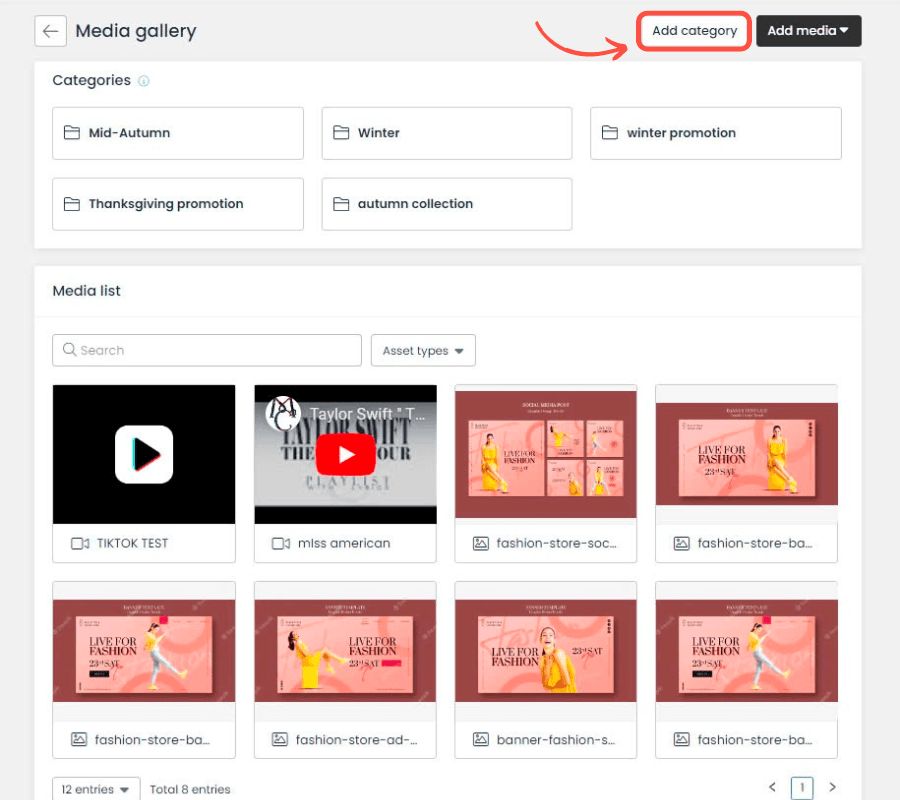
UpPromote also allows you to customize affiliate dashboards. You can add your branding elements and enhance your affiliates’ working experience.
With the UpPromote affiliate portal, your affiliates can discover:
- Affiliate links and coupon
- Media gadgets
- Detailed information & guide about your program
- Real-time tracking dashboard with clicks, sales, and commissions
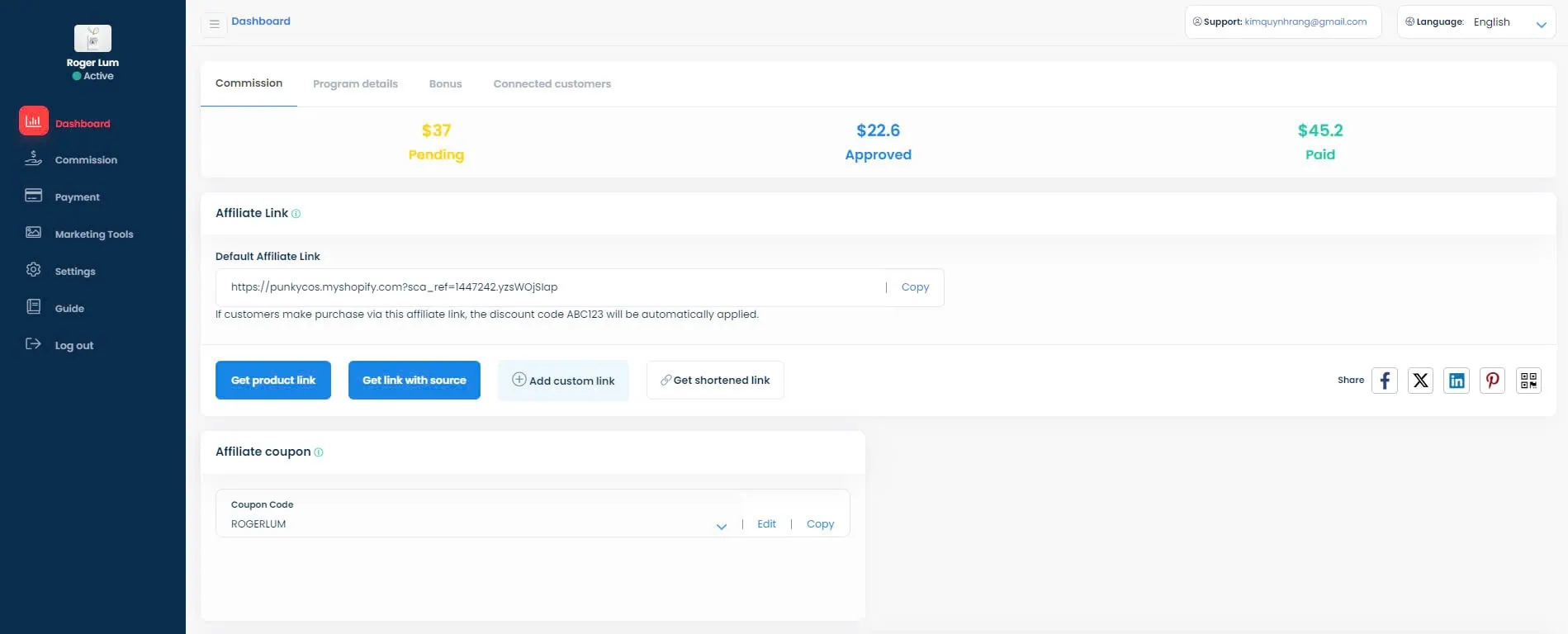
12. Track and optimize affiliate performance
Don’t just launch an affiliate program and then wait for a success overnight. Another important task is to monitor performance and continuously optimize it regularly.
Refer back to the goals and KPIs you outlined earlier to assess how well your program is performing.
For accurate insights, implement a reliable affiliate tracking solution that delivers real-time data and comprehensive reports & analytics on affiliate performance.
With UpPromote, you can easily track the progress of your affiliate program. The platform lets you monitor important metrics like the total affiliates, orders, sales, clicks, and commissions. All the data is displayed in easy-to-read graphs, making it simple to analyze your program’s results.
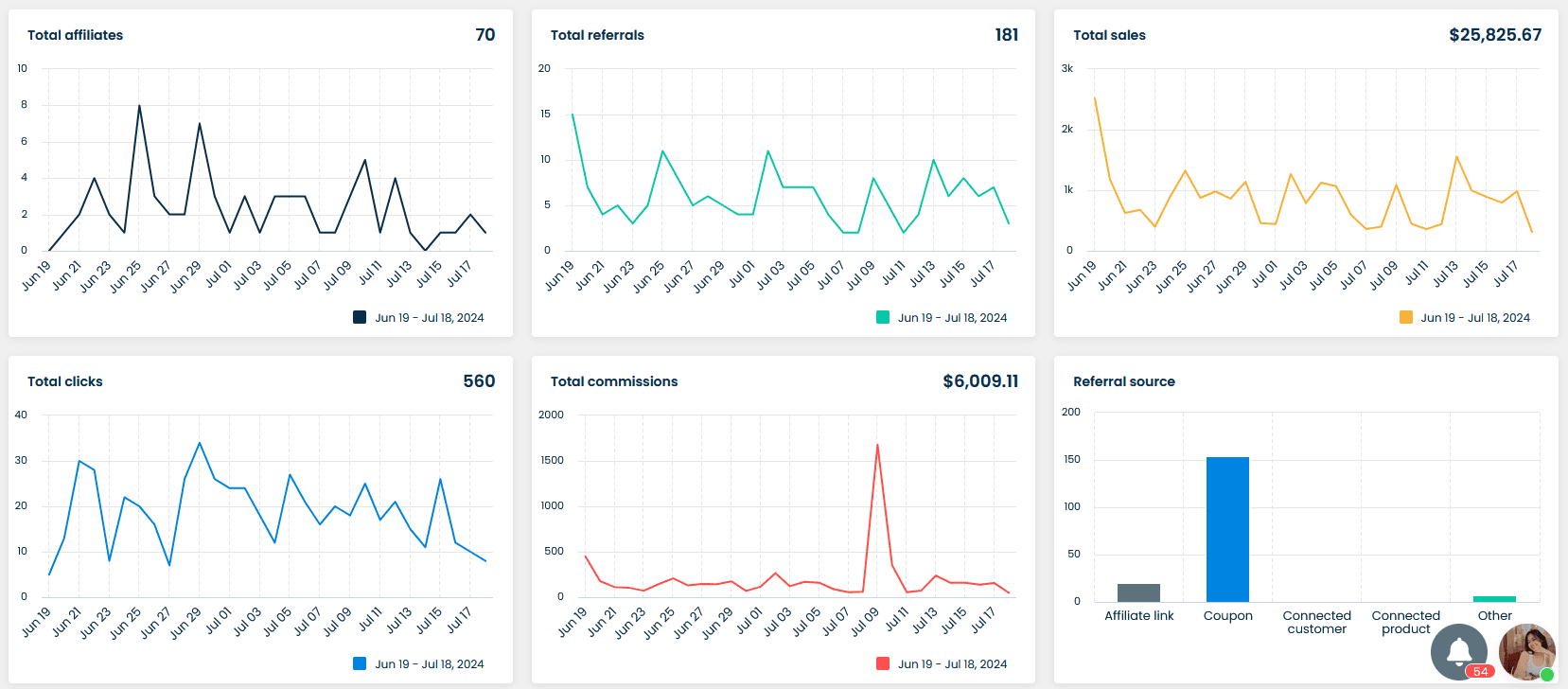
By tracking affiliate performance, you can see what works and what doesn’t. Then, you can make data-driven decisions to optimize your campaign, such as:
- Ask affiliates who have not reached their targets about any problems. Offer timely support.
- Tailor incentives based on affiliate performance. This will keep your top partners motivated.
- Test different commission types or rates. Find out the best ones to encourage affiliates to perform better.
Holbrook Pickleball is just one of the many real-world examples of how to make this affiliate marketing strategy effective.

On their side, they don’t just set a sales goal and then sit back, waiting for their partners to try and reach that amount. Rather, they closely tracked their affiliates’ sales with UpPromote’s analytics dashboard.
If an affiliate goes above and beyond, Holbrook makes sure to thank such performers by sending gift packages via UpPromote’s gift feature.
By keeping an eye on real-time data, Holbrook can send promptly incentives that keep their affiliate marketers motivated and excited to promote their products. And the results speak for themselves: Affiliate revenue grew by an impressive 86% in just one year.
“We look at the analytics section all the time, like every single day. It’s really useful and helps us a lot in making insightful decisions about what to do next.”
Olivia – Holbrook Pickleball Marketing Manager
13. Communicate and foster relationships with affiliates
Good communication helps form good partnerships. And it’s still true with affiliate marketing. Here are some tips for you:
- Update regularly: Inform your affiliates via e-mail, message, or even a call about program updates, new products to be launched, and general promotional activity.
- Personalize communication: Offer feedback tailored to each affiliate’s performance, highlighting their strengths and areas for improvement.
- Create a community: Establish a community forum or online group where affiliates can engage with one another by sharing best practices, challenges, and success stories.
- Acknowledge success: Celebrate affiliates’ achievements through emails, extra commissions, or public shout-outs.
- Provide ongoing support: Schedule regular calls, offer timely help, and make sure the affiliates have the latest marketing materials.
With UpPromote, it’s easy to connect with and communicate with your affiliate marketers.
In our dashboard, click on Outreach > Affiliate Communication. You have 2 options to choose from:
- In-app chat: You can discuss with affiliates right in our app and send them direct messages.

- Email: Customize our templates to reach far more affiliates much faster. Send mass emails updating all affiliates about any changes in your program.
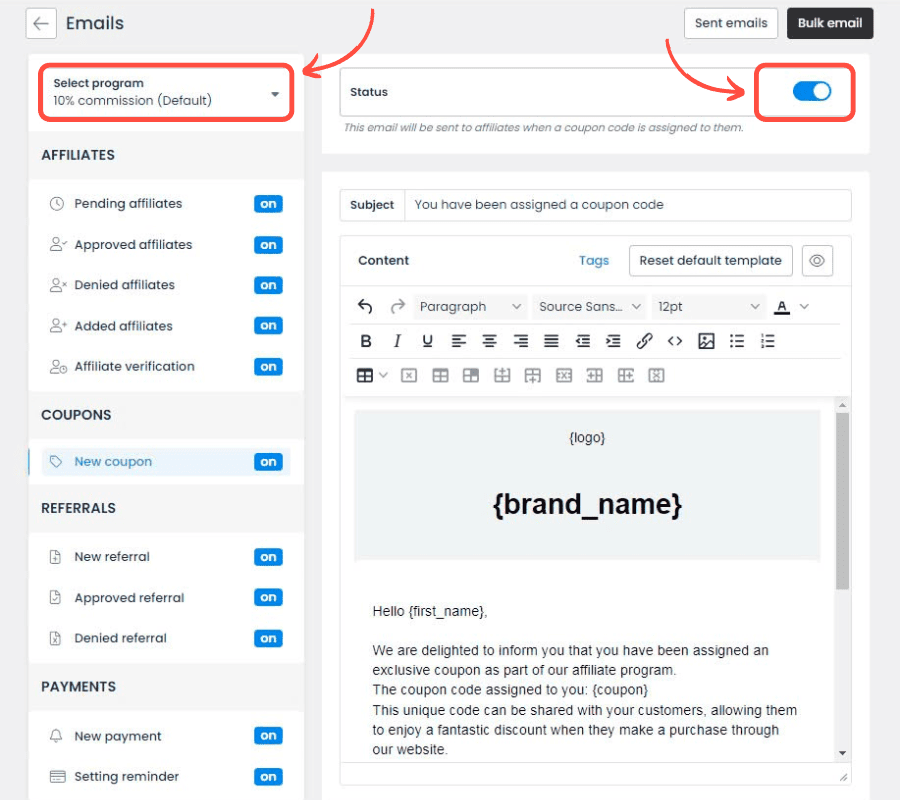
14. Motivate affiliates with bonuses
A good affiliate manager believes that rewards at the right time can give recognition for the hard work of affiliates and encourage them to be even more diligent. So, don’t forget to give extra bonuses to your partners when they perform well and hit excellent sales targets.
Incentives for your partners can take the form of gift cards, free products, or exclusive discounts, but most affiliates prefer cash bonuses.
If you are an UpPromote user, you can easily reward your top partners.
To create bonuses, just navigate to Motivation > Bonuses > Create new bonus.
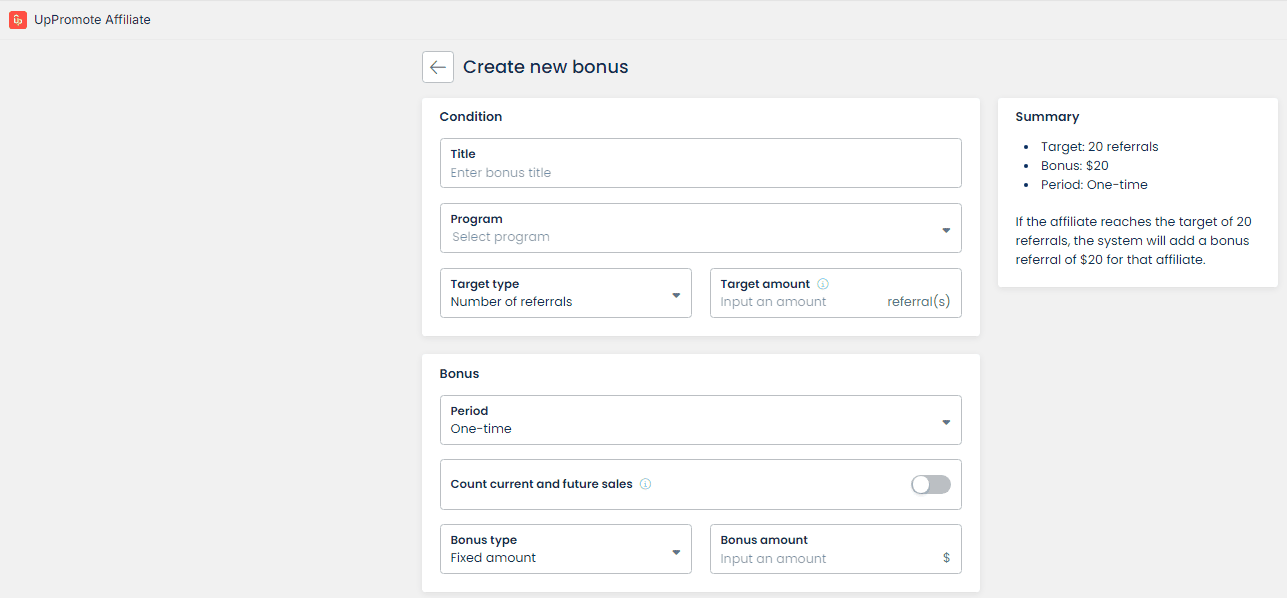
Next, set the bonus conditions. Select a Target Type, such as the Number of Referrals, Total Sales, or Total Commission. Remember to enter the Target Amount.
UpProme enables you to choose a bonus rule: One-time or Periodic (monthly, quarterly, or annually).
Activate UpPromote’s powerful settings & customize dynamic incentives to boost affiliate engagement.
15. Prevent fraudulent activities
Affiliate fraud is a major issue, costing businesses billions annually. According to the lead cyber security firm CHEQ, ad fraud was about 17% of all affiliate traffic and resulted in losses of about 3.4 billion dollars in 2022.
Affiliate fraud comes in a number of forms, so be sure to look out for these common types:
- Click fraud
- Fake leads
- Cookie stuffing
- Affiliate hijacking
- Purchase fraud
Protect your affiliate program from fraud with these helpful tips:
- Set clear terms: Define rules, list prohibited actions like spam, and outline consequences for violations.
- Monitor data: Oversee traffic, earnings, and conversions to spot unusual activity or spikes.
- Use fraud detection tools: Invest in software to detect issues like cookie stuffing or invalid clicks
- Penalize fraud: Punish fraud on time by holding the commission or clearing the affiliate from your program.
If you are looking for an affiliate marketing app with a built-in fraud detection feature, check out UpPromote.
Within the UpPromote dashboard, go to Settings > Fraud detection. Our system will help you keep your affiliate program secure and protected against fraud.
- Detect fraud signups/ referrals coming from IP addresses with suspicious activities.
- Block specific affiliates from joining your program
- Refuse referrals from suspected IP addresses
- Hide affiliate registration form from search engines
- Allow affiliates from particular countries/regions to sign up for your program
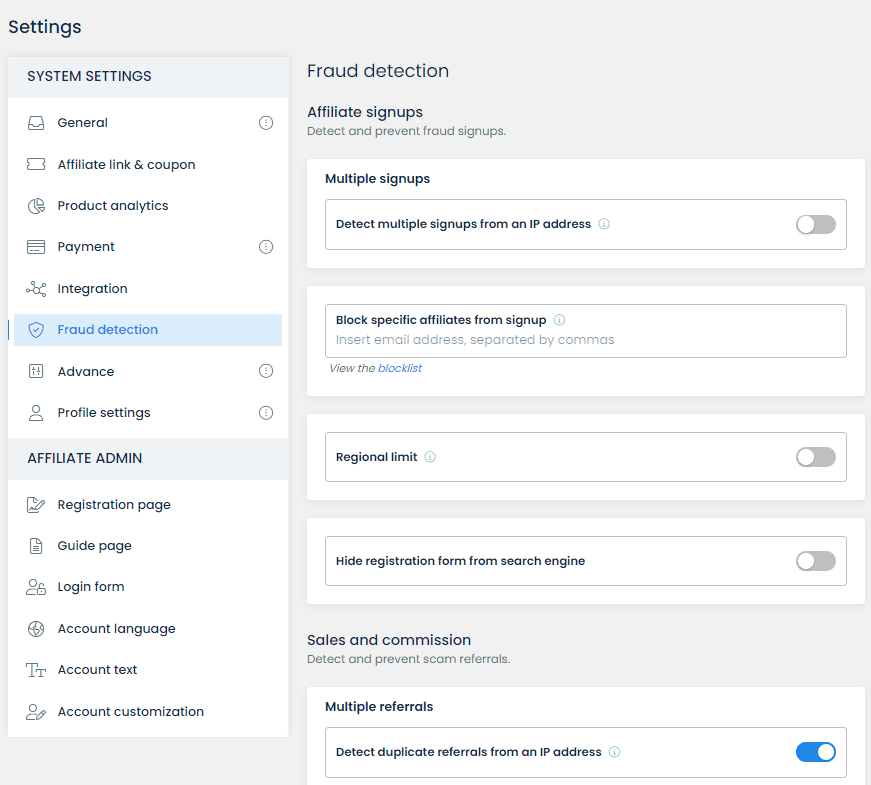
16. Ensure legal and regulatory compliance
Compliance in affiliate marketing saves you from legal fines and disputes; it also helps in trusting your partners.
Key points to keep in mind:
- Follow data privacy laws like GDPR or CCPA, and comply with FTC guidelines for transparency in promotions.
- Draft clear legal documents that outline the terms of your program, including enrollment, affiliate responsibilities, promotional rules, commission structures, and payment methods.
- Ensure clarity on taxes and invoices. Affiliates must know their tax responsibilities and provide necessary documents, like W-9s in the U.S.
Bonus tips:
- Get a lawyer to look over your program to make sure you’re hitting all of your legal marks.
- Use one of the accounting or affiliate tools to simplify tracking taxes and invoices.
With UpPromote, managing taxes and invoices becomes hassle-free.
In our dashboard, go to Settings > Payment > Advance section > Tax on paid commission. There, you’ll find the tax settings.
Based on your situation, decide who will pay the taxes: you or your partners. Next, enter the tax amounts according to local regulations. Our app will calculate taxes for payouts without manual input.
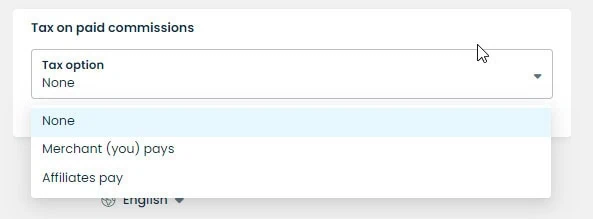
At the same time, you can turn on the Export Invoice function. To meet regional requirements, you can select either the default invoice or the EU format. Both you and your affiliates can download invoices for paid referrals.
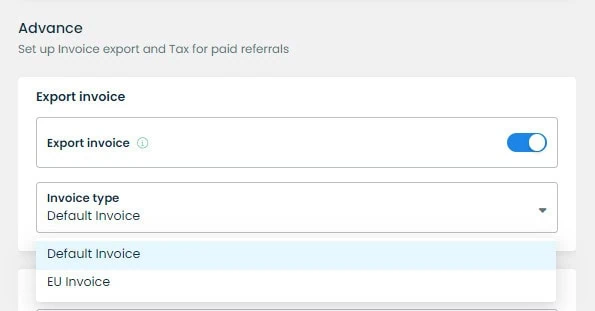
The invoices will contain Invoice ID, Payment method, Payment info, Payment amount, Affiliate name, and Referral details.
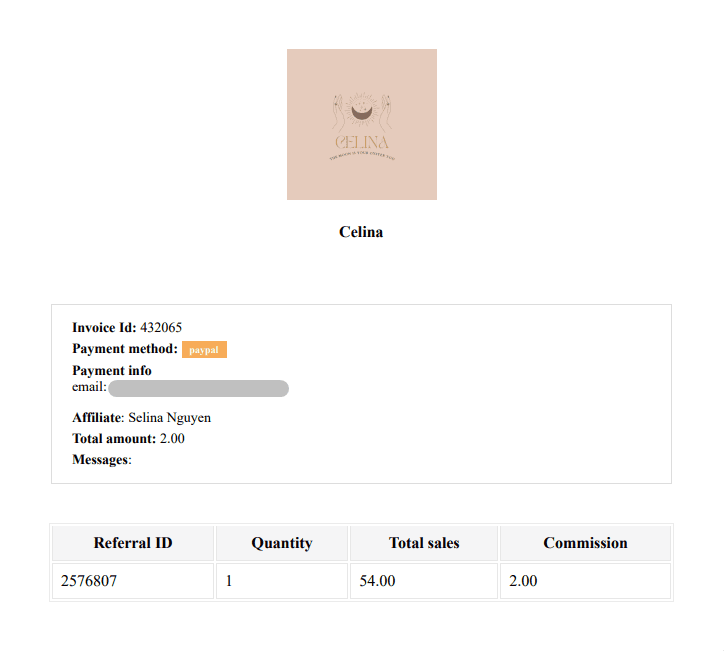
Final words
As we wrap up our affiliate marketing checklist, it’s clear that success in this industry requires the best investment in time and effort. While you might need clarification about how to start and what to do next, we hope this list will assist you in handling difficulties.
As you tick all the boxes in the checklist, you can confidently enter the affiliate marketing landscape. So, grab these strategies and look forward to a successful launch!


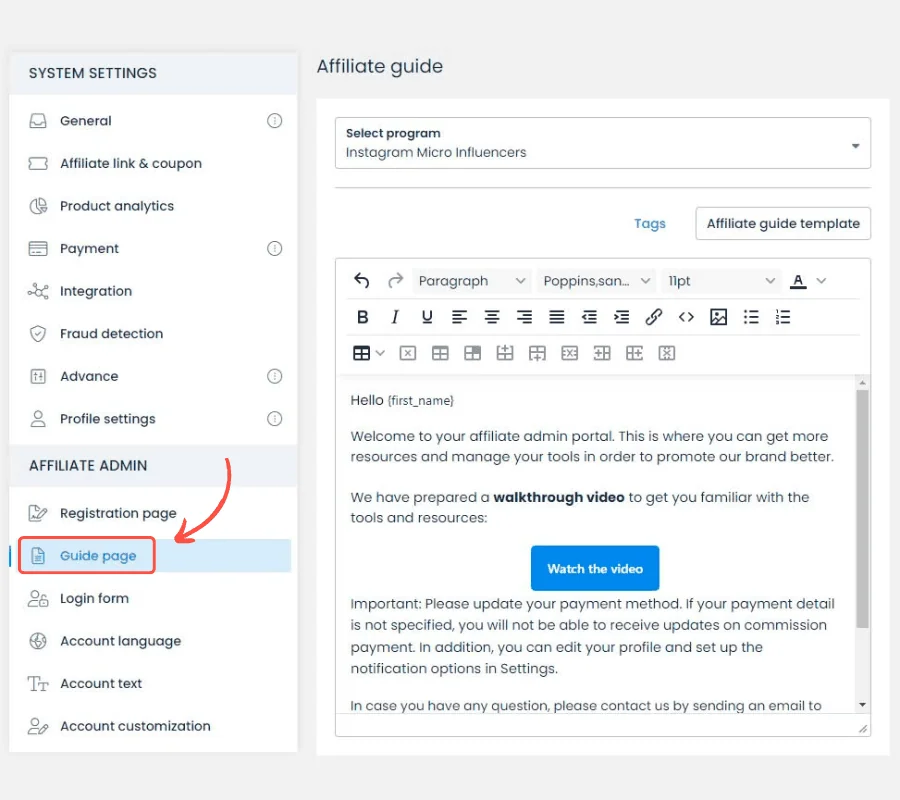 11. Provide affiliates with marketing materials and dashboards
11. Provide affiliates with marketing materials and dashboards





